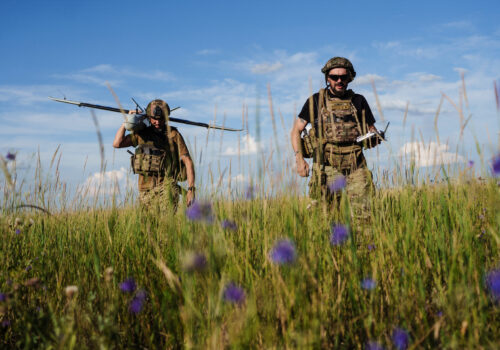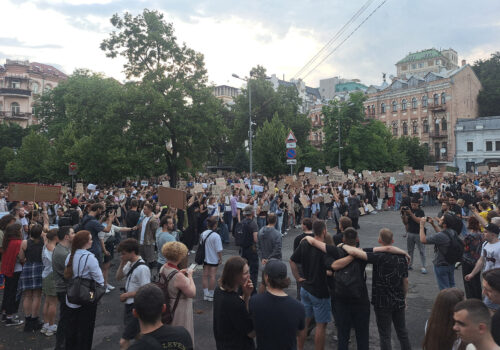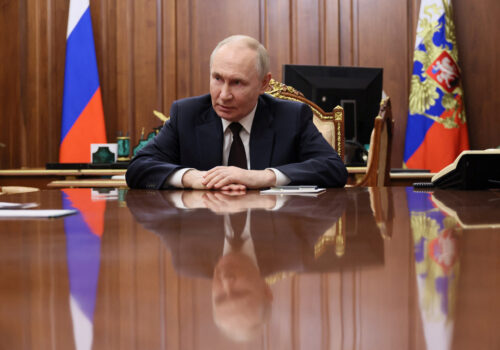Putin may be miscalculating Trump’s resolve on Ukraine
Forty minutes. That’s how long talks between Ukraine and Russia lasted on July 23 in Istanbul. This was enough time to announce a prisoner exchange, but nothing more. There was no progress on achieving a stable cease-fire, and both negotiating teams realized quickly that there was no reason to prolong the talks.
This outcome was no surprise. Dmitry Peskov, spokesman for Russian President Vladimir Putin, said before the talks that the two sides remained far apart. Putin still thinks that he can outlast the United States and Europe, whose support for Ukraine remains crucial, and win the war on the battlefield. He has no interest in the cease-fire that US President Donald Trump continues to seek.
But the real story in recent days has been the growing evidence that Putin is making a serious miscalculation regarding Trump’s policy and the staying power of the West.
Building support ahead of the fifty-day deadline
Moscow was not pleased with what the White House announced on July 14: The United States would now sell advanced weapons to NATO countries for transfer to Ukraine, and it would impose tariff sanctions of 100 percent on Russia and its trading partners if a stable cease-fire in Ukraine were not in place within fifty days. Dmitry Medvedev, former Russian president and current deputy chairman of Russia’s security council, was quick to dismiss the US announcement, noting that it would not move the Russian position. Indeed, Moscow seems to consider Trump’s statement bluster—designed to bluff Putin into agreeing to a cease-fire but unlikely to be implemented once it becomes clear that Moscow will not agree.
What has happened since Trump’s July 14 announcement, however, is a steady increase in US and Western support for Ukraine and a concomitant toughening of NATO policy toward Russia.
Regarding weapons, the principal focus has been on air defense and specifically US-produced Patriot batteries and interceptor missiles. During the visit to Washington last week of German Defense Minister Boris Pistorius, the two countries reached a general agreement on providing five Patriot batteries with missiles to Ukraine. As part of this deal, Germany would buy two Patriot batteries with missiles and send two of its current batteries to Ukraine.
Trump took two additional steps this week toward implementation of his July 14 weapons decision. First, the United States and the European Union signed an agreement for Brussels to fully fund the purchase of US weapons, some of which will be sent to Ukraine. Second, the US State Department announced a $322 million sale to Ukraine for HAWK Phase III air defense systems and repair parts for Bradley infantry fighting vehicles. On the horizon is a possible deal that would send Ukrainian drones to the United States in exchange for other US weapons to Kyiv.
The Ramstein group, which has coordinated the provision of substantial military aid for Ukraine since shortly after Moscow’s full-scall invasion, also met July 21, with the United Kingdom and Germany in the chair. (The United States had led the group until Trump’s return to the White House.) The July 21 meeting was bad news for Moscow, as well. Norway, the Netherlands, and Canada announced $1.3 billion in military aid to Ukraine. More than $500 million of this aid is slated to go to the coproduction with Ukraine of drones and missiles, an initiative agreed at an earlier Ramstein session.
Not letting Putin control the clock
Moscow also witnessed two steps in the past two weeks to strengthen NATO. First, General Chris Donahue, the commander of US Army forces in Europe, said publicly that NATO forces could easily take Kaliningrad, the Russian exclave lodged between Poland and the Baltic states. While Moscow immediately denounced this as a provocation, it is actually a very late and welcome response to years of Russian provocations in the region, including regular violations of NATO air space and territorial waters, and the jamming of airplanes of NATO members. It is further confirmation that the June NATO communiqué meant it when it identified Russia as a threat to European security.
The second step was the reported deployment of US nuclear weapons to the United Kingdom. Their return comes after a hiatus of nearly two decades.
The Kremlin can’t be happy with the current direction of US and NATO policy. But Moscow’s reaction is unlikely to involve reconsidering its current aggression in Ukraine. In fact, Moscow tried to use this week’s demonstrations in Kyiv and other cities against Zelenskyy’s misguided decision to place independent anti-corruption agencies under the control of the prosecutor general. The Kremlin clumsily called them protests against Zelenskyy’s defense of Ukraine against Russia’s invasion; the Ukrainian president also nimbly defused the crisis by reversing his decision.
Russia’s aim is to delay. Moscow has suggested that Trump and Putin could meet in Beijing in September, when Chinese President Xi Jinping will host a celebration to mark the eightieth anniversary of the end of World War II in the Pacific. This is an obvious attempt to tempt Trump to extend his fifty-day deadline for placing tariff sanctions on Russia and its principal trading partners if there is no agreed cease-fire in Ukraine.
The Kremlin is playing for time. Putin is still counting on Trump to back off his efforts to end the war. Putin’s timeline is long—unless the Russian economy crashes. Trump and US allies and partners need to demonstrate that they are in this for the long haul. Only that can bring Putin to accept a durable peace with an independent Ukraine.
John E. Herbst is the senior director of the Atlantic Council’s Eurasia Center and a former US ambassador to Ukraine.
Further reading
Thu, Jul 24, 2025
Ukraine is now an indispensable security partner for the US and Europe
UkraineAlert By
Ukraine's million-strong army and unique experience of the twenty-first-century battlefield makes it an indispensable security partner for the United States and Europe, writes Oleksiy Goncharenko.
Tue, Jul 22, 2025
Ukraine rocked by first wartime protests amid attacks on anti-corruption agencies
UkraineAlert By Andrew D’Anieri
For more than a decade, Ukrainians have been fighting a two-front war: against Russian aggression and against high-level political corruption. So it's puzzling to see Kyiv move to gut independent anti-corruption agencies, writes Andrew D'Anieri.
Thu, Jul 17, 2025
Time remains on Putin’s side. That must change.
New Atlanticist By Caroline Zier
The United States can take five specific actions now to disabuse the Russian president of the belief that he can simply play for time in Ukraine.
Image: US President Donald Trump gestures while boarding Air Force One, as he departs for Scotland, at Joint Base Andrews, Maryland, U.S., July 25, 2025. REUTERS/Evelyn Hockstein/File Photo



